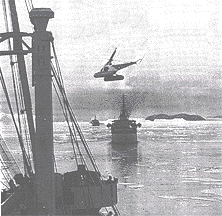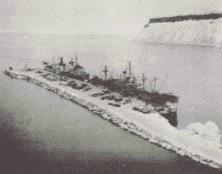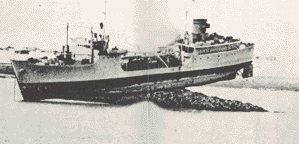
Helicopter flies ice patrol for Operation SUNAC
In late 1952, while American attention was focused on the conflict on the Korean peninsula and toward the Cold War brewing in Europe, the Military Sea Transportation Service disclosed something unique in American military history, a secret operation. As part of Operation SUNAC (Support of North Atlantic Construction) ships of the MSTS ventured into the Labrador Sea, Davis Strait, and Baffin Bay for two seasons (1951-52) to construct radar outposts along the eastern shore of Canada, and western Greenland.

Helicopter flies ice patrol for Operation SUNAC
Commanded by Rear Admiral LJ Huffman and under the direction of the first commander of MSTS, Vice Admiral Callaghan, 37 ships of MSTS, mainly time-chartered Victory ships, transported the necessary equipment while transports served as barracks for Army and Air Force engineers during the construction phase.
The location of Thule, 700 miles north of the Arctic Circle, required the ships to sail in company with icebreakers from the Canadian and American Navy and Coast Guard. Due to the heavy flow ice, ships needed to depart by early September, or face a winter trapped in the ice. The mission posed serious dangers to the crews and ships. The tanker USNS Sappa Creek experienced a radar malfunction and while in reduced visibility struck an iceberg and suffered severe damage to its bow, but was able to continue its mission.

Pier at Thule, Greenland
The most unusual incident occurred to USNS Wacissa, one of the many small T-1 tankers operated by MSTS. The ship, operated under contract by Marine Transport Lines Inc., and commanded by Alexander McLarnon, sailed into Upper Frobisher Bay off Baffin Island during the summer of 1952. Traveling in ballast, the ship struck hard upon a reef, opening its cargo tanks and pump room to the frigid Arctic waters. The master ordered a SOS sent and the Air Force relay station on Nottingham Island informed MSTS Atlantic.

USNS Wacissa in the Arctic at low tide
Responding to the stricken ship, the one-of-a-kind USNS Redbud (T-AKL 398), an ex-Coast Guard buoy tender whose original mission as a radio communication ship was a guise for its real role as an Arctic support ship, sailed for the bay to offer assistance. When the Redbud arrived, Captain Ole O Holm witnessed a unique site. He found the entire length of Wacissa suspended out of the water on a rock outcropping, with it's stern higher than the bow and listing to port.
Unable to free the ship, Holm transferred the 35 crewmembers to his ship and awaited a salvage team to free the land-locked vessel. Forced to wait for a favorable spring tide, the Redbud eventually freed the ship after three attempts and the USS Preserver towed the ship to Nova Scotia for emergency repairs.
| Return to the Details Page |
| Index |
| Return to Top of Page |
Updated: July 29, 2002